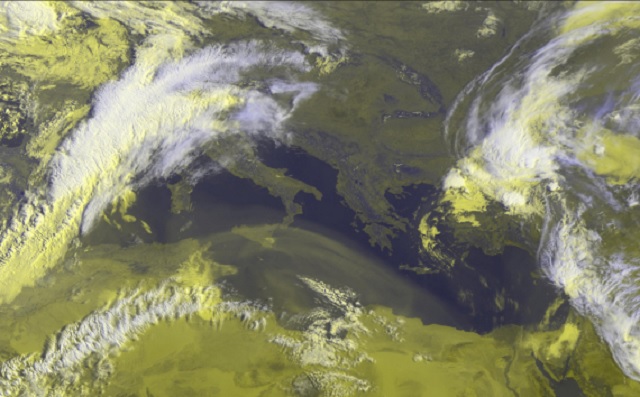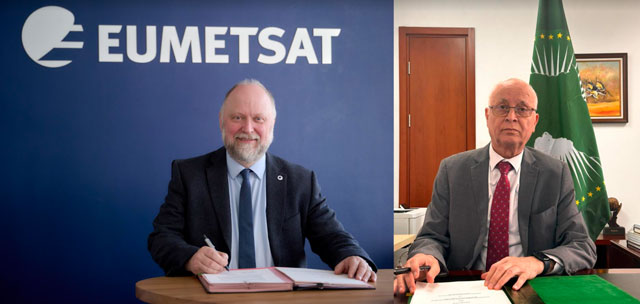
Europe’s satellite agency to strengthen cooperation with continent’s Meteorologists
ANALYSIS | RONALD MUSOKE | The African Union Commission and the European Meteorological Satellite Agency (EUMETSAT), have signed a memorandum of understanding to strengthen their cooperation on earth observation.
The agreement opens the way for African environmental and meteorological services to access EUMETSAT’s data from its next-generation satellite systems.
It also provides the framework for the European meteorological satellite agency and the African Union Commission to cooperate on “deploying new infrastructure to receive data and build educational materials to ensure the biggest possible impact from the satellite data.”
Prof. Mohamed Belhocine, the Commissioner for Education, Science, Technology, and Innovation at the African Union Commission signed the memorandum on behalf of the AU. He noted that the agreement is timely and complements the Agenda 2063 and the African Space Policy and Strategy in deploying satellite data to address environmental and climate challenges.
“The memorandum of understanding represents another milestone in Africa-Europe cooperation. It is a renewed opportunity for Africa to explore EUMETSAT’s next generation infrastructure and tools for data harvesting and utilization.
“Such a mutual partnership is crucial for Africa’s drive to leverage its socio-economic transformation using space science and technology,” he said.
The European meteorological satellite agency based in Darmstadt, Germany, is tasked with monitoring weather and climate from space and providing its 30 European member states with meteorological imagery and data that are essential for keeping their communities safe and for the benefit of critical sectors of their economies.
EUMETSAT has been providing African nations with data and capacity building support for more than two decades, within the framework of the European Union-Africa Partnership. It is a key partner of the African Union in projects aiming to strengthen Africa’s meteorological, environmental and climate services.
But this agreement will facilitate access to more of the precise, high-resolution data those data users in Africa need to help protect lives, infrastructure and livelihoods.
“The agreement recognises and supports Africa’s space, meteorological and climate strategies,” said Phil Evans, the EUMETSAT Director-General.
The latest memorandum is a follow-up to the signing of a formal cooperation agreement between the African Union Commission and the EUMETSAT reached upon in May 2022, under the Intra Africa Caribbean and Pacific states Climate Services and Related Applications Programme. In Africa, that programme is implemented by the African Union Commisison.
Amb. Josefa Sacko, the Commissioner for Agriculture, Rural Development, Blue Economy and Sustainable Environment of the African Union noted at the time that the ClimSA would contribute to Africa’s achievement of a number of the AU Agenda 2063 Goals and the UN Sustainable Development Goals.
“Of direct relevance is achieving Goal 7 of the AU Agenda 2063 ‘Environmental Sustainability and Climate Resilient Economies and Communities and the UN Sustainable Development Goal 13 which speaks to ‘taking urgent action to combat climate change and its impacts.”
Already, the Germany-based EUMETSAT has begun deploying its Meteosat Third Generation (MTG) satellite system, with the launch of MTG-Imager 1 in December 2022.
According to a statement from the EUMETSAT, the satellite’s imagers have a constant view of Africa, as well as Europe, and its data will be released for operational use soon. The organisation’s next-generation of polar-orbiting satellites, EUMESAT Polar System – Second Generation, will begin to be launched in 2025-26.
Africa’s obsolete weather forecasting systems
The memorandum between the African Union Commission and the EUMETSAT comes at a time when African countries are increasingly getting vulnerable to severe weather events which are not only devastating people’s livelihoods but are also wreaking economies.

In their August 2023 paper titled: “How to reduce Africa’s undue exposure to climate risks,” published in the journal, Nature, a team of risk experts and climatologists from the UK and Africa led by the University of Cambridge noted that Africa is disproportionately exposed to catastrophic climate, hydrological and meteorological risks.
They said the climate crisis is increasing the frequency and intensity of floods, droughts and heatwaves and Africa is expected to be among the global regions hit hardest. Yet, for a long time, weather forecasting services across Africa have suffered from a lack of investment.
Weather experts say weather forecasting is an intricate undertaking and even for the most equipped systems, they require millions of data points to measure elements such as temperature, rainfall, humidity, solar radiation and wind intensity and direction.
These elements are collected on land, lakes and oceans, in the atmosphere and by satellites, and then analyzed by powerful computers using complex mathematical models to predict weather patterns.
But, in Africa, the systems and technologies across the continent that monitor and forecast weather events and changes to water levels are often missing, outdated or malfunctioning leaving people across the continent exposed to the vagaries of climate change.
The authors co-led by Dr. Asaf Tzachor from the University of Cambridge’s Centre for the Study of Existential Risk (CSER) point to latest research showing that over the last two decades–the average number of deaths caused by a flooding event in Africa is four times higher than the European and North American average per flood event.
In their investigation of this this disparity, the researchers looked at World Meteorological Organisation (WMO) data and found the entire continent of Africa has just 6% of the number of radar stations as the U.S and Europe’s combined total, despite having a comparable population size and a third more land.
For instance, in Europe and the U.S., there are 636 radar stations for a total population of 1.1 billion and a landmass of 20 million sq km. In Africa, there are just 37 for a comparable population of 1.2 billion and landmass of 30 million km sq km.
According to a 2019 report by the World Meteorological Organisation (WMO), even when climate change is said to be increasing the intensity and frequency of extreme weather events, the continent has the world’s least developed land-based weather observation network.
In a recent analysis of data, the WMO noted that up to half of the 37 available radar stations are unable to produce accurate enough data to predict weather patterns for the coming days or even hours.
Radar stations detect weather fluctuations and rainfall as well as long-term climate trends, and are vital for the forewarning of impending floods and other meteorological events. They are vital for tracking weather fluctuations and rainfall and for forewarning of floods and other hazards.
However, WMO data shows that more than 50% of the radar stations that do currently operate across Africa are unable to produce accurate enough data to predict weather patterns for the coming days or even hours.
“The need for more weather stations across Africa is undeniable, but this must go hand-in-hand with improved satellite monitoring and major training initiatives to increase the number of skilled African meteorologists,” noted Dr. Dr. Asaf Tzachor, the co-lead author and research affiliate at Cambridge’s Centre for the Study of Existential Risk (CSER).
The Cambridge University researchers called upon the international community to boost funding for systems that mitigate risks to life from climate disasters on the continent. Currently, just US$0.47 of every US$100 spent on global development aid goes towards disaster risk reduction of any kind.
“The vast gaps in Africa’s disaster reduction systems are in danger of rendering other aid investments redundant,” he said, “For example, there is little point in investing in smallholder farms if floods are simply going to wash away seeds, agrochemicals, and machinery.”
“We need to offer all Africans a chance to reduce the exposure to climate risks by fixing this glaring hydro-meteorological blind-spot, before ever more lives are lost to the effects of global heating.”
In an illustration of their argument, the team compare two recent category-4 storms: Tropical cyclone Idai hit southeast Africa in 2019 and Hurricane Ida swept the eastern U.S in 2021.
Both had windspeeds of over 200km/hr. U.S populations received evacuation alerts before Ida hit land, but the limited ‘hydromet’ capabilities meant Idai caught African nations by surprise. The U.S death toll was under a hundred, while over a thousand people in Africa perished.
“Multi-layered hydromet systems, including weather monitoring, forecasting and early warning, are taken for granted by the Global North, and have been for decades,” said co-lead author, Dr. Catherine Richards, also from CSER at the University of Cambridge.
Among the Cambridge University’s researchers’ recommendations for plugging Africa’s weather-warning gap is a ramping up of investments in Africa’s weather forecasting system and this is mainly because of the likely dividends that countries across the continent are likely to recoup.
“Well-funded hydromet systems must become a priority to help at-risk populations mitigate and adapt to weather-related hazards as the effects of climate change take hold,” said Dr Richards, a co-lead author of the paper.
“The World Bank has estimated a US$1.5 billion price tag for continent-wide hydromet systems, but it would save African countries from US$13 billion in asset losses and $22 billion in livelihood losses annually,” said Dr Tzachor. “A nearly nine-to-one return on investment is surely a no-brainer.”
 The Independent Uganda: You get the Truth we Pay the Price
The Independent Uganda: You get the Truth we Pay the Price



